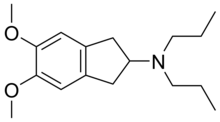PNU-99,194
PNU-99,194 | |
| 임상 데이터 | |
|---|---|
| 루트 행정부. | 오랄 |
| ATC 코드 |
|
| 법적 상태 | |
| 법적 상태 |
|
| 식별자 | |
| |
| CAS 번호 | |
| PubChem CID | |
| 켐스파이더 | |
| 유니 | |
| 첸블 | |
| CompTox 대시보드 (EPA ) | |
| 화학 및 물리 데이터 | |
| 공식 | C17H27NO2 |
| 몰 질량 | 277.408 g/120−1 |
| 3D 모델(JSmol) | |
| |
PNU-99,194(A)(또는 U-99,194(A))는 D [1][2][3]아형보다2 D에 대해 153~30배 이상 선호되는 중간 선택성3 D 수용체 길항제 역할을 하는 약물이다.비록 D3을 D2에 훨씬 더 많은 선호한닸다는 사실이 PNU-99,194 약하게, 그것은 좀 더 선택적인(100-fold)과 행동 일치하지 않는다는)수용기 antagonists 둘 다 prolactin 분비와striatal 도파민 합성 S-14,297과 GR-103,691를 자극한다에서 경험했듯이 후자의 수용체는 여전히 그 효과에, 어떤 역할을 한다..[4]
설치류 연구에서 PNU-99,194의 저용량은 두개내 자가자극(ICSS)에 영향을 미치지 않고 조건부 장소선호(CPP)를 생성하는 반면, 7-OH-DPAT와 같은 D 작용제의 저용량은3 ICSS 동작을 억제하고 조건부 장소선호(CPA)[5][6][7]를 유발한다.이와는 대조적으로, PNU-99,194의 고용량은 CPA를 생성하고 ICSS를 억제하는 반면, 7-OH-DPAT의 고용량은 [5][6][7]그 반대의 결과를 초래한다.이와 병행하여, PNU-99,194와 7-OH-DPAT의 저선량은 각각 과잉활동과 저활성화를 유도하는 반면, 두 [2][3][7][8][9][10]약제의 고선량에서는 그 반대가 나타난다.이러한 데이터는 D 수용체가 보상3 메커니즘과 운동기 활성에 대해 쌍상 효과가 있음을 나타내며, 이는 시냅스 [8][11]후 수용체와 자가 수용체의 상반된 역할 때문일 가능성이 높다.
PNU-99,194의 낮은 복용량에서 설치류에서 다른 효과를 배우는amphetamine-induced 보상과 행동 sensitization,[18][19]과morphine-induced CPP갱신을 위한 반전의 아픔을 주는 responses,[12]hypothermia,[4][13]anxiolysis,[14]과 노련과 memory,[12][15][16][17]뿐만 아니라 증원과 억제, 각각 포함한다.[6]고용량에서는 쥐와 [1][20]원숭이 모두에서 코카인의 자가 투여를 억제한다.
「 」를 참조해 주세요.
레퍼런스
- ^ a b Claytor R, Lile JA, Nader MA (March 2006). "The effects of eticlopride and the selective D3-antagonist PNU 99194-A on food- and cocaine-maintained responding in rhesus monkeys". Pharmacology Biochemistry and Behavior. 83 (3): 456–64. doi:10.1016/j.pbb.2006.03.007. PMID 16631246. S2CID 39482275.
- ^ a b Waters N, Svensson K, Haadsma-Svensson SR, Smith MW, Carlsson A (1993). "The dopamine D3-receptor: a postsynaptic receptor inhibitory on rat locomotor activity". Journal of Neural Transmission. General Section. 94 (1): 11–9. doi:10.1007/bf01244979. PMID 8129881. S2CID 32918280.
- ^ a b Kling-Petersen T, Ljung E, Svensson K (1995). "Effects on locomotor activity after local application of D3 preferring compounds in discrete areas of the rat brain". Journal of Neural Transmission. General Section. 102 (3): 209–20. doi:10.1007/bf01281155. PMID 8788069. S2CID 10327706.
- ^ a b Audinot V, Newman-Tancredi A, Gobert A, et al. (October 1998). "A comparative in vitro and in vivo pharmacological characterization of the novel dopamine D3 receptor antagonists (+)-S 14297, nafadotride, GR 103,691 and U 99194". The Journal of Pharmacology and Experimental Therapeutics. 287 (1): 187–97. PMID 9765337.
- ^ a b Kling-Petersen T, Ljung E, Wollter L, Svensson K (1995). "Effects of dopamine D3 preferring compounds on conditioned place preference and intracranial self-stimulation in the rat". Journal of Neural Transmission. General Section. 101 (1–3): 27–39. doi:10.1007/bf01271543. PMID 8695055. S2CID 30848393.
- ^ a b c Francès H, Smirnova M, Leriche L, Sokoloff P (September 2004). "Dopamine D3 receptor ligands modulate the acquisition of morphine-conditioned place preference". Psychopharmacology. 175 (2): 127–33. doi:10.1007/s00213-004-1807-9. PMID 15095031. S2CID 2721240.
- ^ a b c Khroyan TV, Baker DA, Neisewander JL (December 1995). "Dose-dependent effects of the D3-preferring agonist 7-OH-DPAT on motor behaviors and place conditioning". Psychopharmacology. 122 (4): 351–7. doi:10.1007/BF02246265. PMID 8657832. S2CID 20542615.
- ^ a b Millan MJ, Seguin L, Gobert A, Cussac D, Brocco M (July 2004). "The role of dopamine D3 compared with D2 receptors in the control of locomotor activity: a combined behavioural and neurochemical analysis with novel, selective antagonists in rats". Psychopharmacology. 174 (3): 341–57. doi:10.1007/s00213-003-1770-x. PMID 14985929. S2CID 1592299.
- ^ Gyertyán I, Sághy K (July 2004). "Effects of dopamine D3 receptor antagonists on spontaneous and agonist-reduced motor activity in NMRI mice and Wistar rats: comparative study with nafadotride, U 99194A and SB 277011". Behavioural Pharmacology. 15 (4): 253–62. doi:10.1097/01.fbp.0000137857.26150.ab. PMID 15252275. S2CID 41821358.
- ^ Rodríguez-Arias M, Felip CM, Broseta I, Miñarro J (May 1999). "The dopamine D3 antagonist U-99194A maleate increases social behaviors of isolation-induced aggressive male mice". Psychopharmacology. 144 (1): 90–4. doi:10.1007/s002130050981. PMID 10379629. S2CID 20953625. Archived from the original on 2000-07-12. Retrieved 2010-04-30.
- ^ Meyer ME (October 1996). "Mesolimbic 7-OH-DPAT affects locomotor activities in rats". Pharmacology Biochemistry and Behavior. 55 (2): 209–14. doi:10.1016/S0091-3057(96)00066-4. PMID 8951956. S2CID 46728735.
- ^ a b Casarrubea M, Sorbera F, Crescimanno G (November 2006). "Effects of 7-OH-DPAT and U 99194 on the behavioral response to hot plate test, in rats". Physiology & Behavior. 89 (4): 552–62. doi:10.1016/j.physbeh.2006.07.014. PMID 16919688. S2CID 45464906.
- ^ Boulay D, Depoortere R, Rostene W, Perrault G, Sanger DJ (April 1999). "Dopamine D3 receptor agonists produce similar decreases in body temperature and locomotor activity in D3 knock-out and wild-type mice". Neuropharmacology. 38 (4): 555–65. doi:10.1016/S0028-3908(98)00213-5. PMID 10221759. S2CID 1004412.
- ^ Rogóz Z, Kłodzińska A, Maj J (2000). "Anxiolytic-like effect of nafadotride and PNU 99194A, dopamine D3 receptor antagonists in animal models". Polish Journal of Pharmacology. 52 (6): 459–62. PMID 11334239.
- ^ Laszy J, Laszlovszky I, Gyertyán I (May 2005). "Dopamine D3 receptor antagonists improve the learning performance in memory-impaired rats". Psychopharmacology. 179 (3): 567–75. doi:10.1007/s00213-004-2096-z. PMID 15619116. S2CID 24086632.
- ^ Hale MW, Crowe SF (July 2002). "The effects of selective dopamine agonists on a passive avoidance learning task in the day-old chick". Behavioural Pharmacology. 13 (4): 295–301. doi:10.1097/00008877-200207000-00006. PMID 12218510. S2CID 24698131.
- ^ Hammad H, Wagner JJ (January 2006). "Dopamine-mediated disinhibition in the CA1 region of rat hippocampus via D3 receptor activation". The Journal of Pharmacology and Experimental Therapeutics. 316 (1): 113–20. doi:10.1124/jpet.105.091579. PMID 16162819. S2CID 10007327.
- ^ Carr KD, Yamamoto N, Omura M, Cabeza de Vaca S, Krahne L (August 2002). "Effects of the D(3) dopamine receptor antagonist, U99194A, on brain stimulation and d-amphetamine reward, motor activity, and c-fos expression in ad libitum fed and food-restricted rats". Psychopharmacology. 163 (1): 76–84. doi:10.1007/s00213-002-1132-0. PMID 12185403. S2CID 1840764.
- ^ Chiang YC, Chen PC, Chen JC (May 2003). "D(3) dopamine receptors are down-regulated in amphetamine sensitized rats and their putative antagonists modulate the locomotor sensitization to amphetamine". Brain Research. 972 (1–2): 159–67. doi:10.1016/S0006-8993(03)02522-8. PMID 12711089. S2CID 40067321.
- ^ Gál K, Gyertyán I (October 2003). "Targeting the dopamine D3 receptor cannot influence continuous reinforcement cocaine self-administration in rats". Brain Research Bulletin. 61 (6): 595–601. doi:10.1016/S0361-9230(03)00217-X. PMID 14519456. S2CID 12383682.


